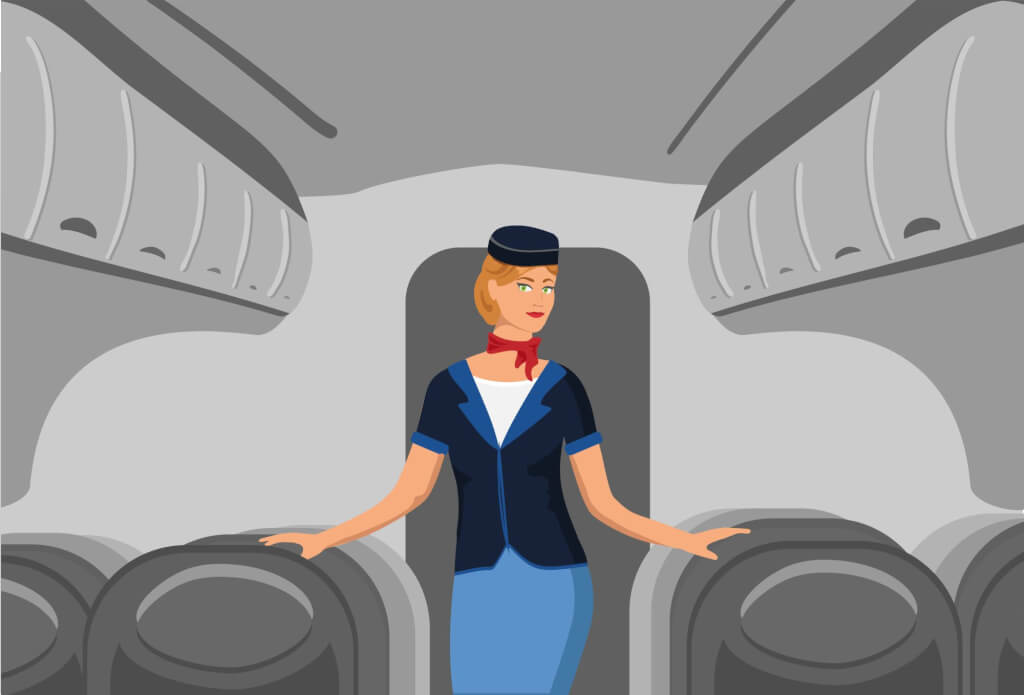Harder than getting to Hollywood: how the flight attendants appeared on the planes and by what criteria they were hired
'19.06.2021'
Source: Adme
A century ago, passenger planes were very small and could only carry 12 passengers and 2 pilots. During the flight, the co-pilot left the cockpit to hand out lunch boxes to passengers, calm those who are afraid of flying, and help those suffering from air sickness. And there were many of them, because the planes flew low, and the aircraft dangled from side to side. AdMe.ru imbued with the story of the world's first flight attendant and decided to talk about how the profession of a flight attendant appeared in general.

The very first flight attendant
Ellen Church was born in Cresco, Iowa, to a family of farmers in 1904, a year after the Wright brothers' successful flight. As a young girl, she watched the planes performing at the local fair: sometimes one of them landed in a nearby field near the Cresco farm. And then the baby decided that when she grows up, she will definitely learn to fly.
After graduating from high school, Ellen went to study as a nurse, and in parallel with this, she privately took aircraft flying lessons. Miss Church soon obtained her pilot's license. In 1929, 25-year-old Ellen offered her services to Boeing Air Transport (now United Airlines). However, at that time it was impossible to even imagine that the girl was at the helm of the plane, and she was expectedly refused.
The world's first steward, Heinrich Kubis, also flew on the famous Hindenburg airship and escaped during a plane crash.
However, the manager of the company Steve Stimpson made a counter offer to Miss Church. He knew that a year earlier, German air carriers had decided to establish the position of a third crew member - a steward, whose responsibility was to take care of the passengers who had previously been occupied by the co-pilot. Boeing Air Transport also decided to add a third crew member to passenger flights. But, according to their plan, they had to be a girl.
Smiling beauties, demonstrating the absence of fear at high altitude, were supposed to have a soothing effect on both passengers and their relatives waiting for them on the ground. And if the flight attendants, like Ellen, have a medical education, they will also be able to provide first aid to passengers who become ill due to air sickness.
On the subject: 'Fasten your seatbelts': stewardess revelations about what actually happens in flight
Requirements for the first flight attendants
Ellen was hired as a senior flight attendant and ordered to find 7 more nurses to work on the planes. Although the girls were offered a very solid salary of $ 125 per month for those times, it was not so easy to find applicants. Firstly, many parents simply did not allow their daughters to do this dangerous, in their opinion, job. Secondly, strict requirements were imposed on the applicants.
The first planes could not bear the heavy weight, so the flight attendant had to weigh a maximum of 115 pounds (about 52 kg). In addition, the cabin had narrow aisles and low ceilings, so applicants could not be taller than 5'4 '' (1,63 cm). In addition, there was also an age limit of 25 years.
Ellen and her 7 subordinates have worked hard to prove that women can do this job. They took care of unhealthy and frightened passengers, checked tickets, handed out lunches, served coffee and hot soup, and after the flight ended, cleaned the cabin and tightened the bolts that held the seats to the floor.
One of the girls' most important duties was to monitor the emergency exit, which was located next to the toilet. The flight attendants made sure that passengers did not miss the door and did not accidentally go outside at an altitude of 5000 feet (1524 m). In addition, the flight attendants had to carry the train schedule with them in case the plane crashed.
Ellen worked for only a year and a half: she was in a car accident and received an injury that prevented her further career in aviation. However, 10 years later, she returned to the skies joining the army corps of nurses: Church helped to evacuate wounded soldiers from Africa and Italy by aircraft. Now the airport in her hometown of Cresco is named after the world's first flight attendant.
How the image of the stewardess has changed
Following the example of Boeing Air Transport, other airlines also hired nurses as flight attendants, and the profession began to skyrocket in popularity. The fact is that in the United States in the 1930s, this work was one of the few where women were allowed, while the country was covered by the Great Depression. Thanks to these factors, in December 1935, 2000 girls applied for 43 positions offered by transcontinental and local airlines.
The requirements for applicants were tough. In addition to compulsory medical education, girls were bound to be unmarried. If an employee got married, she lost her job. The same was true for pregnancy. When a flight attendant turned 32 (in some companies, 35), she was retired. Thus, the seniority of female employees rarely exceeded a couple of years.
Despite the fact that from the very moment of the emergence of the profession of a flight attendant, employers paid attention to the appearance of employees and relied on their prettiness, the first uniforms of girls were mainly practical and comfortable - there was no talk of sexuality yet. Some airlines dressed stewardesses in nurse costumes, others in military style.
In the 1940s, many nurses were drafted into the army, so airlines stopped specifying the appropriate education among the mandatory requirements for their employees. The stewardesses were no longer medical staff on board, and this affected their appearance. The uniform has become more tight-fitting, complemented by white gloves and high heels.
In the 1960s, the appearance of flight attendants became more revealing. Pacific Southwest Airlines dressed the employees in extremely short skirts, and later in shorts. The sexuality of female employees was actively used in advertising. In 1971, US National Airlines launched a Fly me campaign with smiling inviting flight attendants and slogans like "I'm Lorraine, take me to Orlando."
At the same time, in the same 1960s, flight attendants began to actively fight for their rights. As a result, by the end of the decade in the United States, airlines were banned from hiring exclusively female flight attendants, and by the 1980s, the marriage ban was lifted. In the 1990s, the weight requirement for flight attendants was relaxed.
In September 1998, at the assembly of the International Civil Aviation Organization (ICAO), from the English. ICAO - International Civil Aviation Organization, representatives of all states agreed to consider that the existing official name of the profession of flight attendants and stewards Flight Attendant (literal translation - "flight assistant") should be replaced with Cabin Crew - "crew of the liner cabin". This was done in order to enhance the status and role of these specialists in ensuring safety on board the aircraft.
On the subject: 'For failure to comply with an order - death': stories of flight attendants who saved passengers at the cost of their lives
Defending the rights of flight attendants has led to changes in their appearance. In 2015, Israel's EL AL airline introduced a requirement for female flight attendants to wear high heels until passengers were seated, but the union said the requirement would endanger the health and safety of employees and instructed its members ignore this rule. The requirement was dropped in the same year.
Despite the fact that in most cases flight attendants are dressed in tight-fitting uniforms with a skirt and high-heeled shoes, and they always have makeup on their faces, the requirements for their appearance are relaxed. In 2019, Virgin Atlantic allowed flight attendants to wear pants and not wear makeup.
In the modern world, there is no official age limit for flight attendants. One of the oldest flight attendants in the world is 84-year-old Betty Nash, who has been in her position for over 60 years and is rightfully considered the mascot of American Airlines. And the oldest flight attendant at the time of employment was 59-year-old Catherine Heinos, who was hired by Virgin Atlantic in 2014.
What do you think, are strict requirements for the appearance of a flight attendant necessary?







